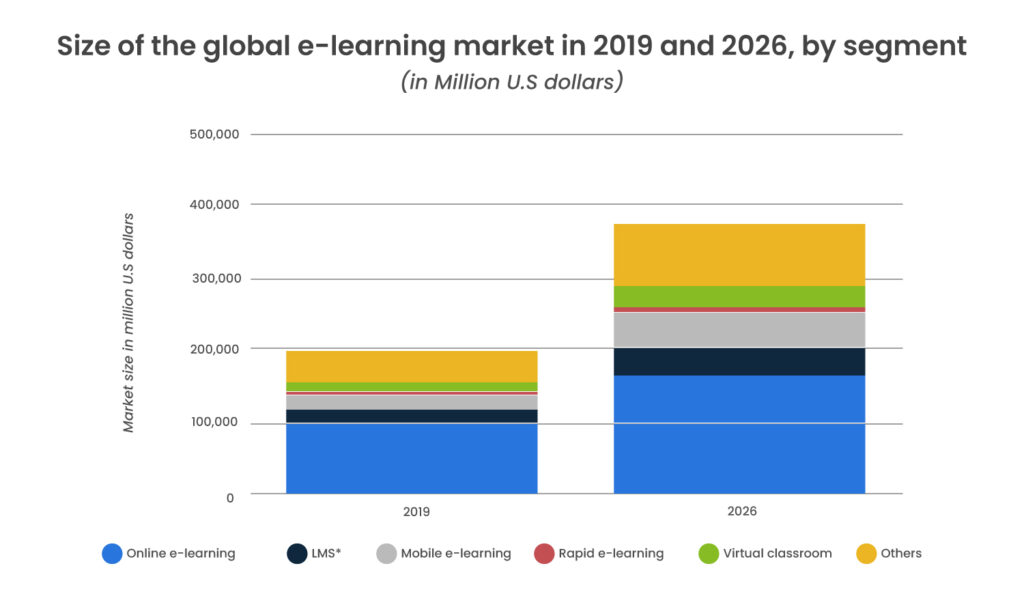
A learning system that incorporates digital technologies, and electronic resources to deliver learning & knowledge via an online platform is known as e-learning or online learning. Conventional teaching methods include methodology where instructors and learners are present in a classroom in real-time and face-to-face instructions occur. An online learning method involves digital platforms such as web-based platforms, mobile app platforms, tablets, and likewise. Online learning means a remote-based learning methodology where learners and trainers/providers are connected virtually irrespective of geographic locations and time zones. In an online learning landscape, the internet happens to be the major component. In short, digital devices, digital technologies, and adequate networking systems are the basic requirements for creating an environment for digital learning/online learnine/e-learning.
Description
Integrating technology with education has become a big priority now. Online learning is undergoing massive progress across the education industry. Educational institutes, schools, colleges, coaching centers, research centers, and skill up-gradation course providers, all are adopting digital to their ecosystem. The online learning system is being accepted by the masses, across the education landscape and varied stakeholders are getting unparalleled benefits out of it. Smartphones, mobile devices like tablets, desktops, smart speakers, smart TV, etc. have forayed into the households bringing learning, and home education, connecting people virtually on a remote basis.
For Instance
In classrooms, instructors can leverage the digital learning format while learners can avail of classes from their homes or offices. Web & mobile app-based learning has replaced the standard classroom model of teaching; teachers and students connect via mobile learning apps and allow the system to function more efficiently while increasing the productivity of all. Live classes, digitally-powered audio-video lectures, AI-ML, and AR-enabled web & mobile applications are allowing huge cost-saving and time-saving opportunities for education businesses the world over.
Statistics
- TWO out of FIVE Fortune 500 companies adopt e-learning tools & methodologies
- The global e-learning market is projected to reach US$370 Billion by 2026
- The global market size of the corporate e-learning industry is projected to reach over US$37 billion by 2026.

Advantages
- Convenience – 24×7 access, no commuting, and mobile phones can serve the purpose.
- Improved Learning – Equal emphasis on varied skills like writing, technology skills, group discussions, and life skills.
- Equal opportunity -Anonymity of the online forum allows shy students to open up and grow.
- Enhanced Interactive sessions – Quality-based student-to-student or student-to-teacher interactions.
- Great learning outcomes– Passive listening is less and active listening becomes prominent and good synergy.
- Innovative learning/teaching – Addresses varied learning styles and student-centered activities.
- Digitally powered Administration – Documentation, records, evaluation, grading, etc. are easily managed.
- Increased student satisfaction and Retention – Online learning facilitates high retention due to increased satisfaction levels and cost-saving opportunities.
- No physical campus required- Online courses can be availed of without attending physical campuses and providers can maintain huge cost-cutting otherwise included on rents, etc.
Present Online Learning
Edtech or education technology is becoming the face of the education industry today and online learning is picking momentum at an exponential rate. Although the COVID-19 crisis has led to a significant surge in this segment, the adoption of online learning and educational technologies started trending much before; in 2019, the global edtech investments reached a massive US$18.66 billion. By 2025, the overall market for online education is estimated to reach 350 Billion USD. Uasegewise, there’s an increasing surge in virtual learning apps, language apps, online tutoring, online-video conferencing tools, as well as varied online learning software! Edtech incorporates digital tools that facilitate online learning and online teaching over virtual platforms. Digital technologies like AR-VR, IoT, Blockchain, AI-Ml, etc. allow for smooth and seamless online learning functionalities.
AI as a Mainstream Technology
AI (Artificial Intelligence) has a major influence on the present learning system. The massive capabilities of this technology are transforming e-learning systems globally. Personalized learning is one of the valuable assets of AI. Other ways how AI is impacting online learning in present times are:
- Automating classroom activities for schools/colleges
- Allowing the personalized learning system
- Predictive analysis of students for better outcomes
- Automating admin tasks across learning domains
- AI-led extra support allows easy comprehension and understanding of concepts
Online Learning in Future
Online learning is expanding its reach across the globe and stakeholders are poised to leverage digital technologies for enhanced and productive learning fetching lucrative outcomes. Universities, colleges, and schools are focusing on hybrid models that allow the smooth integration of online learning into their existing patterns. Adrian Alba, Recruitment Director for Arizona Online at the University of Arizona speaks thus, “If you’re not, as a university, looking at online options or improved technology systems for your students, I think you could potentially fall behind the curve.” Below are a few snapshots of the future of online learning trends that are substantiated by experts working on the front line of e-learning/online education :
- Introduction of more online degrees in colleges/schools.
- More STEM courses in Data Science, Physical Science.
- Growth of OER(Open Educational Resources). Educational resources like online learning materials, textbooks, and streaming videos will be available at no cost/low cost.
- VR(Virtual Reality) powered online hands-on courses/programs like biology, chemistry lab programs, nursing, or science programs will grow. Online skill demonstrations and interactive videos to be accessible online will empower students, interns, and research scholars, and will increase their engagement level.
- Blended learning will become prominent creating a concrete digital future for educational institutions.
- Enhanced course designs will reduce the digital divide. Courses will be accessible across devices and remote areas.
- MOOCs(Massive Open Online Courses) will gain popularity towards skill-up-gradation among online learners.
- Stackable online credentials will grow meant for working people, and job candidates to enhance their portfolios. Especially in technical areas like IT and healthcare.
- Online boot camps will grow via strong public-private partnerships. For example, in the area of coding, designing, research, etc.
- Skill-based credentials and certification will become top criteria for hiring managers, and they won’t focus on mere degrees of candidates.
Conclusion
Online learning is allowing an unabated learning environment where all stakeholders get to gain in some way or the other. The virtual mode of interactions helps to overcome geographical & language barriers besides time constraints. Companies are leveraging online learning forums towards skill-upgrading programs for their employees; universities, schools, and colleges are allowing seamless learning benefitting learners and providers on a global scale. It’s a win-win situation across the lanes.
If you are a Start-Up, SMB, or an Enterprise in the online learning segment, you need to be future-ready right Now! Explore the massive digital capabilities that can fetch you greater ROI, contact our experts today.


